
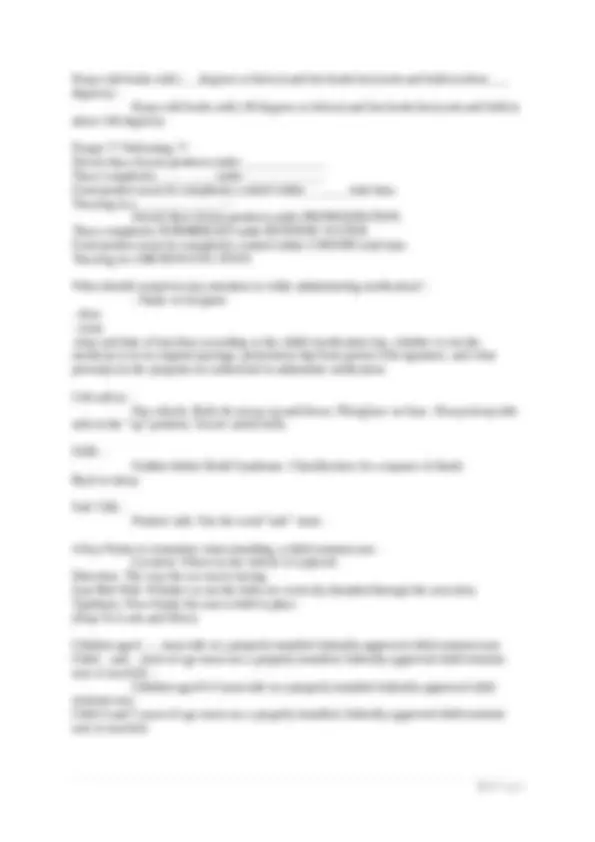
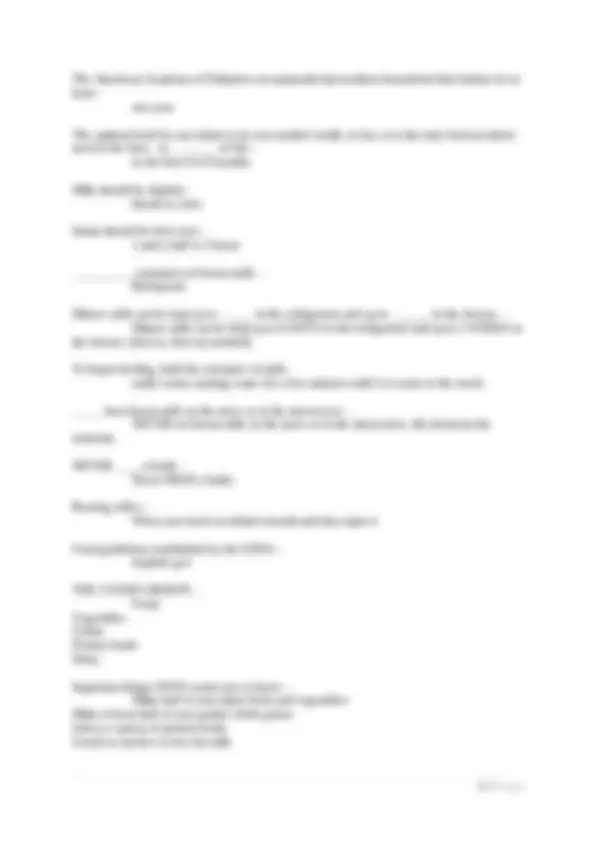
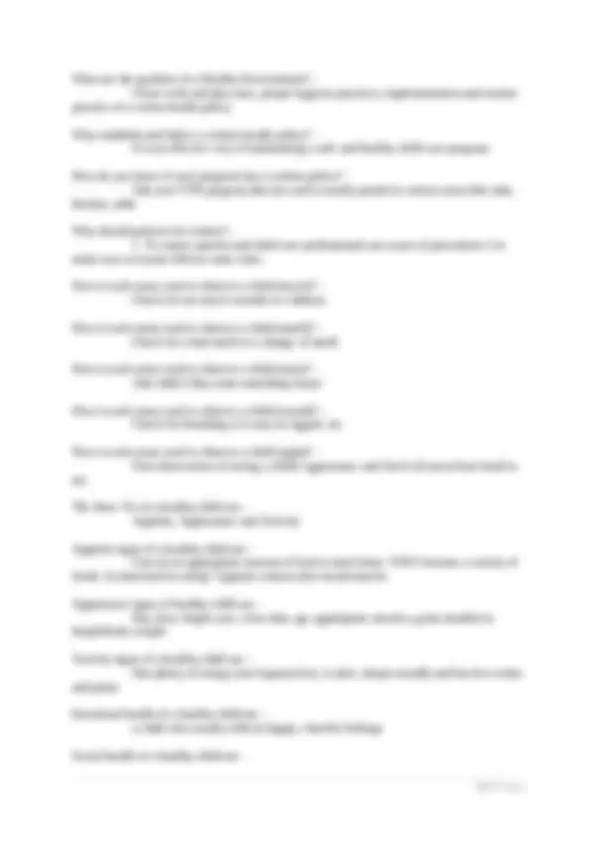
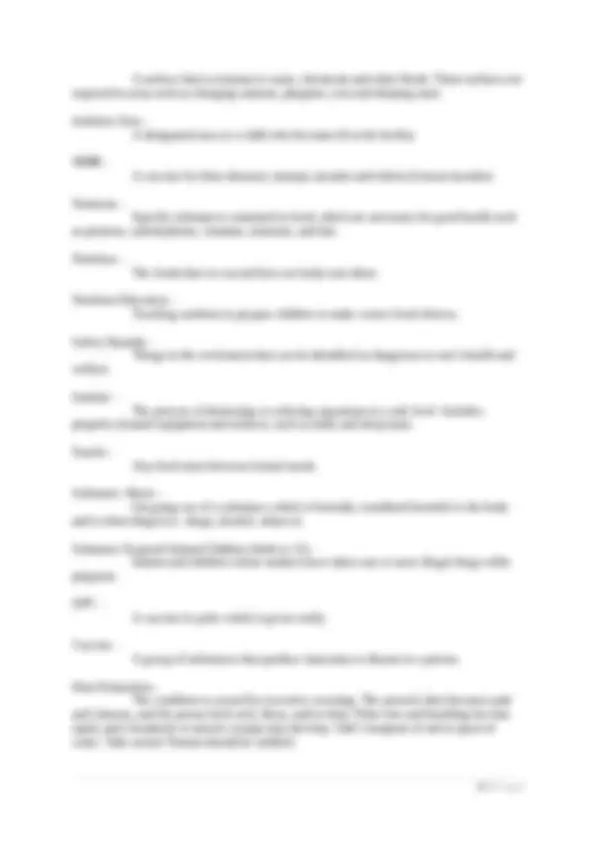
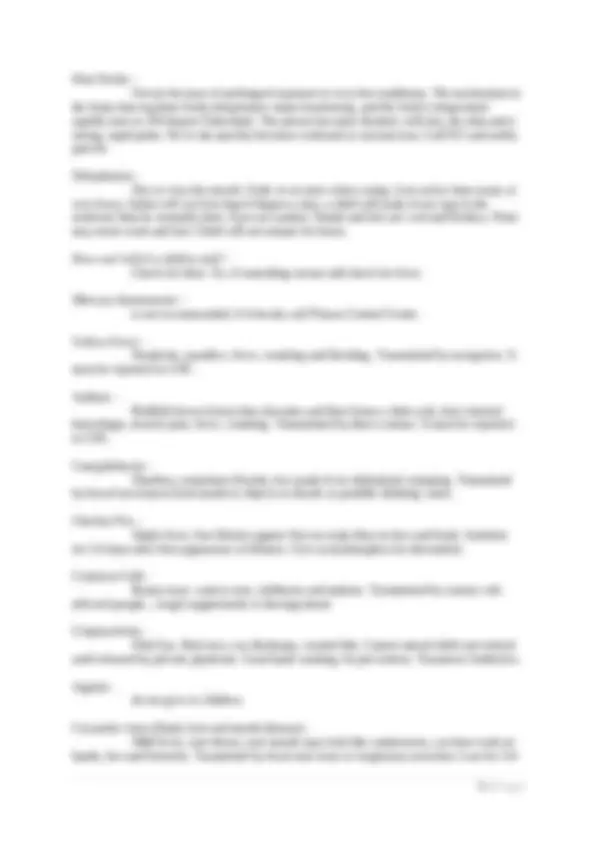
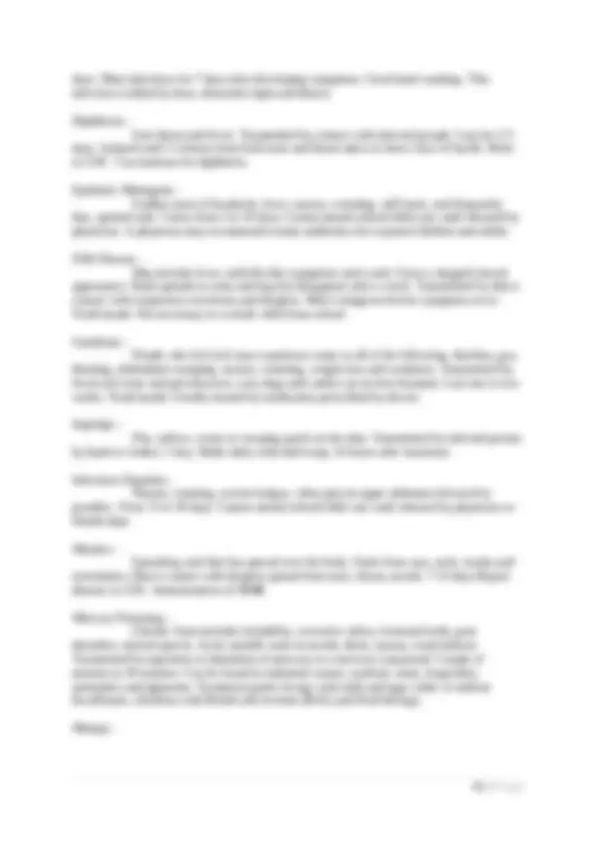
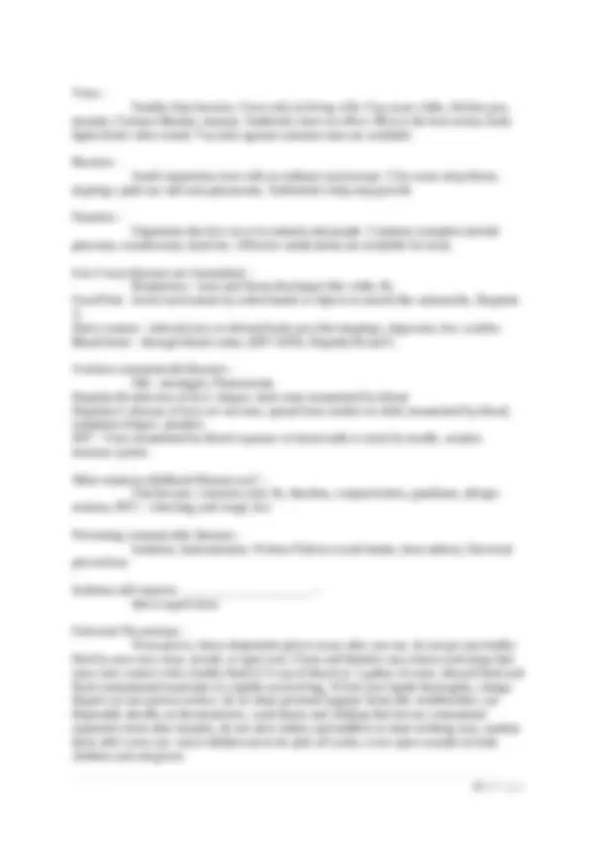
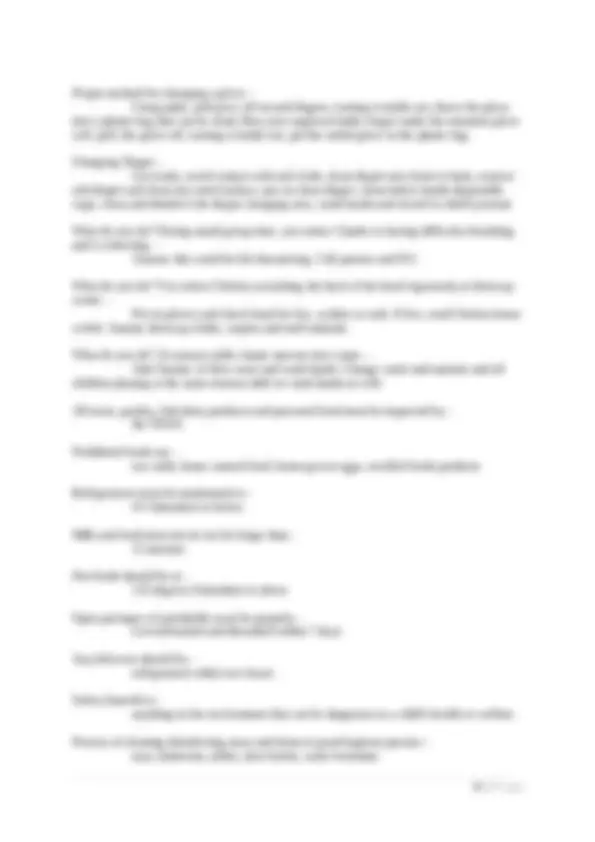
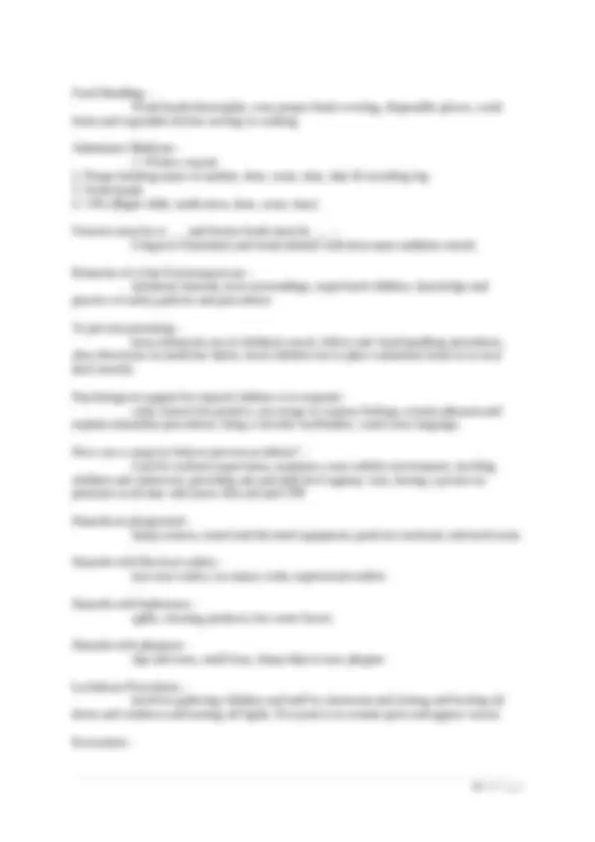
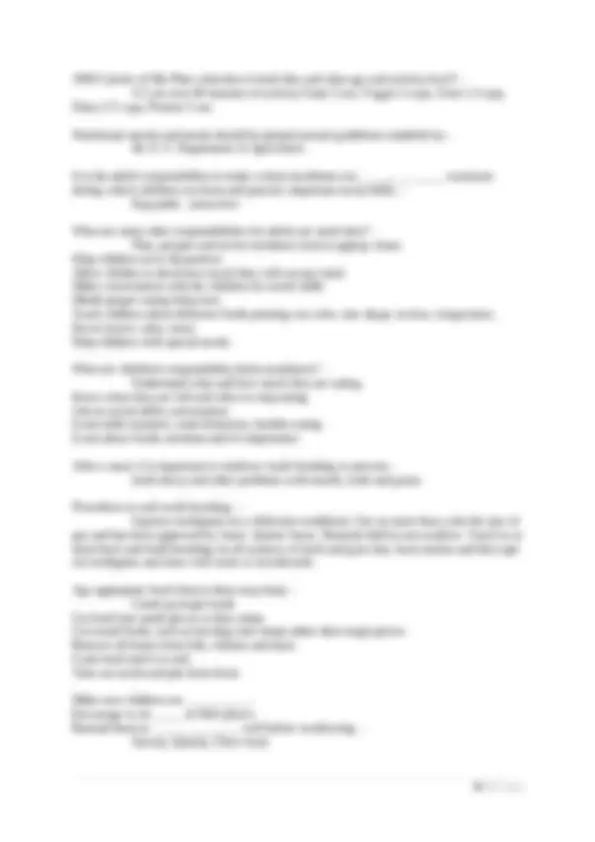
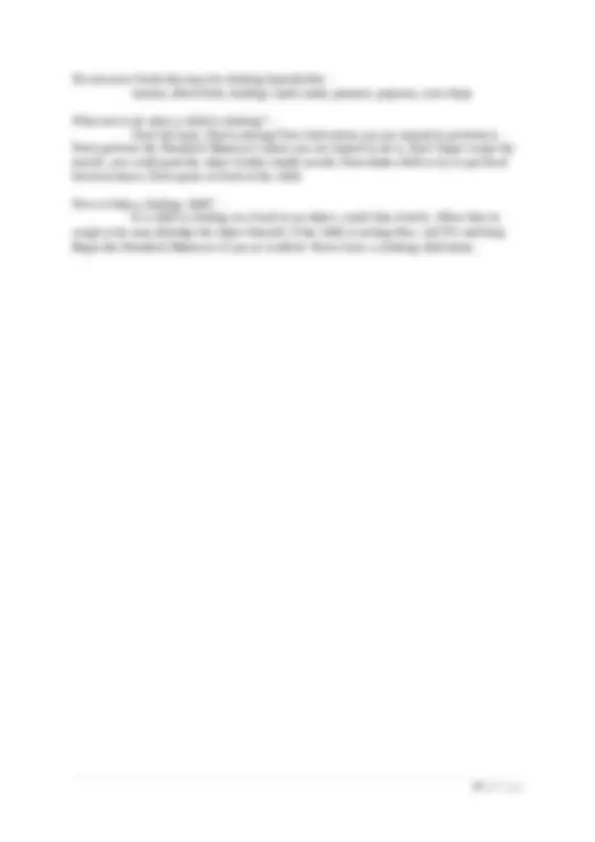


Study with the several resources on Docsity

Earn points by helping other students or get them with a premium plan


Prepare for your exams
Study with the several resources on Docsity

Earn points to download
Earn points by helping other students or get them with a premium plan
Community
Ask the community for help and clear up your study doubts
Discover the best universities in your country according to Docsity users
Free resources
Download our free guides on studying techniques, anxiety management strategies, and thesis advice from Docsity tutors
A comprehensive overview of essential health, safety, and nutrition guidelines for childcare professionals. It covers topics such as daily health checks, fever management, dehydration, communicable diseases, proper hygiene practices, food storage and preparation, medication administration, crib safety, infant feeding, and healthy environment principles. Designed to equip childcare professionals with the knowledge and skills necessary to create a safe and healthy environment for children.
Typology: Exams
1 / 19

This page cannot be seen from the preview
Don't miss anything!












The three A's of a healthy child are: - Appetite (eat a substantial amount of food, consume a variety of food, interested in eating, appears content after eating) & Appearance (clear bright eyes, clear skin, well-developed muscles, gains steadily in height and body weight) & Activity (has plenty of energy, is alert, sleeps soundly, few aches and pains) Good way of preventing, identifying, and controlling illness in a child care environment. - Daily Health Checks (includes behavior, face and body, other signs) _____ may be a warning sign that the body has an infection and needs treatment before the infection can become harmful. - Fever The best way to take a temperature is to use a _______ ___________ with a __________ _____. - The best way to take a temperature is to use a DIGITAL THERMOMETER with a DISPOSABLE SHEATH. Orally, ___ degrees or more is a fever. Under arm, ___ degrees or more is a fever. - Orally, 101 degrees or more is a fever. Under arm, 100 degrees or more is a fever. If dehydration is sever, the following will occur: -
temperature (104F skin hot to the touch), strong and rapid pulse, confusion or loss of consciousness. Immediate medical attention required- call 911. - Heat Stroke Four types of germs: -
The American Academy of Pediatrics recommends that mothers breastfeed their babies for at least - one year. The optimal food for any infant is its own mother's milk; in fact, it is the only food an infant need in the first _ to _ ______ of life. - in the first 4 to 6 months Milk should be slightly - bluish in color. Infant should be fed every - 1 and a half to 3 hours __________ containers of breast milk. - Refrigerate Mature milk can be kept up to _ ____ in the refrigerator and up to _ _____ in the freezer. - Mature milk can be kept up to 8 DAYS in the refrigerator and up to 2 WEEKS in the freezer. (first in, first out method) To begin feeding, hold the container of milk - under warm running water for a few minutes until it is warm to the touch. _____ heat breast milk on the stove or in the microwave; - NEVER eat breast milk on the stove or in the microwave; this destroys the nutrients. NEVER ____ a bottle - Never PROP a bottle. Rooting reflex - When you touch an infant's mouth and they open it Food guidelines established by the USDA - myplate.gov THE 5 FOOD GROUPS - Fruits Vegetables Grains Protein foods Dairy Important things USDA wants you to know - Make half of your plate fruits and vegetables Make at least half of your grains whole grains Select a variety of protein foods Switch to fat-free or low-fat milk
What are the qualities of a Healthy Environment? - Clean work and play area, proper hygiene practices, implementation and routine practice of a writen health policy. Why establish and follow a written health policy? - It is an effective way of maintaining a safe and healthy child care program. How do you know if your program has a written policy? - Ask your VPK program director and it usually posted in various areas like sink, kitchen, table Why should policies be written? -
Disease - an illness Disinfectant - To kill germs on surfaces or objects by using chemicals to lower the risk of spreading infection DTP - A vaccine for three diseases: diphtheria, tetanus (lockjaw) and pertussis (whooping cough) Evacuation Plan - Procedures for getting children and staff out of the building; applied during the fire drills and any other emergency situation. Health - The total well being of the physical body (including the emotions, the mind and the spirit) and the absence of disease or other abnormal condition. Health Assessment - An estimate of the state of health of a child based upon observation of his or her health history and measurements of phyiscal growth. Health History - A record of major health (and illness) events in a child's life including immunization information. Hepatitis B - Serious viral disease of the liver involving gradual loss of appetite, abdomial discomfot, nausea and vomiting, joint pain and rash. Often jaundice (yellowish tint of eyes and skin) appears later. Hib - A bateria that is the leading cause of baterial meningitis as well as pneumonia, joint or bone infections and throat inflammations. This occurs most often in children during the first five years of life. HIV Positive - Indication through a blood test that one has been infected by the HIV virus, a virus that causes AIDS. Hunger - A phyiscal need for food. Immunization - Administration of a vaccine to make the body build up a defense against a disease. Impermeable surface -
A surface that is resistant to water, chemicals and other fluids. These surfaces are required in areas such as changing stations, playpens, cots and sleeping mats. Isolation Area - A designated area or a child who becomes ill at the facility. MMR - A vaccine for three diseases; mumps, measles and rubela (Geman measles) Nutrients - Specific substances contained in food, which are necessary for good health such as proteins, carbohydrates, vitamins, minerals, and fats. Nutrition - The foods that we eat and how our body uses them. Nutrition Education - Teaching nutrition to prepare children to make correct food choices. Safety Hazards - Things in the enviroment that can be identified as dangerous to one's health and welfare. Sanitize - The process of destroying or reducing organisms to a safe level. Includes properly cleaned equipment and surfaces, such as sinks and sleep mats. Snacks - Any food eaten between formal meals. Substance Abuse - On-going use of a substance which is formally considered harmful to the body and is often illegal (i.e. drugs, alcohol, tobacco) Substance Exposed Infants/Children (birth to 12) - Infants and children whose mothers have taken one or more illegal drugs while pregnant. OPV - A vaccine fo polio which is given orally Vaccine - A group of substances that produce immunity to disease in a person. Heat Exhaustion - The condition is caused by excessive sweating. The person's skin becomes pale and clammy, and the person feels sick, dizzy, and/or faint. Pulse rate and breathing become rapid, and a headache or muscle cramps may develop. Add 1 teaspoon of salt to quart of water. Take action! Parents should be notified.
days. Most infectious for 7 days after developing symptoms. Good hand washing. This infection is killed by heat, ultraviolet light and bleach. Diphtheria - Sore throat and fever. Transmitted by contact with infected people. Last for 2- days. Isolated until 2 cultures from both nose and throat taken to show clear of bacilli. Refer to CDC. Vaccinations for diphtheria. Epidemic Meningitis - Sudden onset of headache, fever, nausea, vomiting, stiff neck, and frequently fine, spotted rash. Varies from 2 to 10 days. Cannot attend school/child care until released by physician. A physician may recommend certain antibiotics for exposed children and adults. Fifth Disease - May include fever, mild flu-like symptoms and a rash. Gives a slapped cheeck appearance. Rash spreads to arms and legs but disappears after a week. Transmitted by direct contact with respiratory secretions and droplets. Most contagious before symptons occur. Wash hands. Not necessary to exclude child from school. Giardiasis - People who feel sick may experience some or all of the following: diarrhea, gas, bloating, abdominal cramping, nausea, vomiting, weight loss and weakness. Transmitted by fecal-oral route and pets (beavers, cats, dogs and cattle) can receive/transmit. Last one to two weeks. Wash hands. Usually treated by medication prescribed by doctor. Impetigo - Flat, yellow, crusty or weeping patch on the skin. Transmitted by infected person by hand or clothes. 5 day. Bathe daily with mild soap. 24 hours after treatment. Infectious Hepatitis - Nausea, vimiting, extrem fatigue, often pain in upper abdomen folowed by jaundice. From 15 to 50 days. Cannot attend school/child care until released by physician or Health dept. Measles - Spreading rash that has spread over the body. Starts from ears, neck, trunks and extremities. Direct contact with droplets spread from nose, throat, mouth. 7-14 days Report disease to CDC. Immunization of MMR Mercury Poisoning - Chronic form includes irritability, excessive saliva, loosened teeth, gum disorders, slurred speech, Acute metallic taste in mouth, thirst, nausea, renal failuere. Transmitted by ingestion or inhalation of mercury or a mercury compound. Couple of minutes to 30 minutes. Can be found in industrial wastes, seafood, water, fungicides, antiseptics and pigments. Treatment gastric lavage with milk and eggs white or sodium bicarbonate, chelation with British anti lewisite (BAL) and fluid therapy. Mumps -
Pain in cheeks, increased by chewing. Swelling over the jaw and in front of the ear. Transmitted by coughing sneezing or saliva. 12 to 18 days Isolate until swelling disappears. Use good hand washing. Vaccine available. Pertussis (Whooping Cough) - Tight dry cough that becomes more severe to croat, vomitting. Transmitted by infecte people. 7 to 10 days. Immunization and booster doses Pinworms - Are tiny white worms. Symptoms are irritation and itching of the anus. Spread by swallowing pinworm eggs from anus to mouth. Isolate as long as eggs are present. Hand washing after toileting/diaper. Consult physician. Plague - Painful enlarged lymph nodes in the axilla, groin or neck, fever rising to 106 F, introduce into the body by the bite of rat flea that has bitten an infected rat. Reportable disease to CDC. Treatment Antibiodics. Polio - Transmitted by infected people. 7 to 12 days Polio Vaccine. Isolation for 1 week. Poliomyelitis - Fever, headache, malaise, gastro disturbance, stiff neck. Often followed by paralysis. 7 to 12 days Cannot attend school until release from physician. Vaccination treatment Rheumatic Fever - Precipitated by a Strep infection. Unknown how it's spread by follows after Strep infection. Use antibiotics. Ringworm - Flat, spreading scaly ring-shaped spots. The magins are usually reddish and elevated. Found on head scalp. Fungi grow easily on moist areas. 2 to 10 days. Consult physician. Rubella (German Measles) - Fever and general body rash. Fist signs may be swollen glands at the back of the skull and behind ears, followed by a rash. The rash fades rapidly and is usually gone within 3 days. Transmitted by sneezing/coughing 14 to 23 days. Cannot attend school until 4 days after onset of rash. Vaccine available. Rubeola Measles - Fever tiredness, cough, runny nose and inflamed eyes. These symptoms worsen over 3 days Blotchy rash apears on fourth day. The cough tends to be worse at night. Transmitted by direct contact with nasal or throat secretions. 7 to 18 days. Cannot attend school until after teh 4 day rash appears. Vaccines available. Scabies - Severe itching, small raised reddened areas or blisters with connectiong grayish- white lines Most commonly found in folds of skin. Transmitted by touch from another body
Virus - Smaller than bacteria. Grow only in living cells. Can cause colds, chicken pox, measles, German Measles, mumps. Antibiotics have no effect. REst is the best action; body fights better when rested. Vaccines against common ones are available. Bacteria - Small organisims seen with an ordinary microscope. CAn cause strep throat, impetigo, pink eye and som pneumonia. Antiboiotics help stop growth. Parasites - Organisms that live on or in animals and people. Common examples include pinwoms, roundworms, head lice. Effective medications are available for most. List 4 ways diseases are transmitted. - Respiratory - nose and throat discharges like colds, flu Fecal/Oral - bowel movements by soiled hands or objects to mouth like salmonella, Hepatitis A Direct contact - infected area or infested body area like impetigo, ringworm, lice, scabies. Blood borne - through blood contac (HIV/AIDS, Hepatitis B and C. 4 serious communicabl diseases - Hib - meningtis, Pnenumonia Hepatitis B-infection of liver, fatigue, dark urine transmitted by blood. Hepatitis C-disease of liver no vaccines, spread from mother to child, transmitted by blood, symptoms fatigue, jaundice HIV - Virus transmitted by blood exposure or breast milk or stuck by needle, weaken immune system. Most common childhood illnesses are? - Chicken pox, common cold, flu, diarrhea, conjunctivities, giardiasis, allergic reations, RSV - wheezing and cough, lice Preventing commuicable diseases - Isolation, Immunization, Written Policies (wash hands, clean tables), Universal precautions Isolation still requires _________ ____________. - direct supervision Universal Precautions - Wear gloves, throw disposiabe gloves away after one use, do not get any bodily fluid in your eyes, nose, mouth, or open sore, Clean and disinfect any sufaces and mops that omce into contact with a bodily fluid (1/4 cup of bleach to 1 gallon of water, discard fluid and fluid contaminated materials in a tightly secured bag, WAsh your hands thoroughly, change diapers on ono-porous surface, do no share personal hygiene items like toothbrushes, use disposable sheaths on thermometers, wash linens and clothing that becom contaminate separately from other laundry, do not alow babies and toddlers to share teething toys, sanitize these after every use. teach children not to be pick off scabs, cover open wounds on both children and caregivers
Proper method for changing a glove - Grasp palm, pull gove off toward fingers, turning it inside out, throw the glove into a plastic bag that can be seted, Run your ungloved index finger under the remainin glove cuff, pull, the glove off, turning it inside out, put the soiled glove in the plastic bag. Changing Diaper - Get ready, avoid contact with soil cloth, clean diaper area front to back, remove soil diaper and clean any soied surface, put on clean diaper, clean baby's hands disposable wipe, clean and disinfect the diaper changing area, wash hands and record in child's journal. What do you do? During small group time, you notice Charles is having difficulty breathing and is wheezing. - Assume this could be life threatening. Call parents and 911. What do you do? You notice Chelsea scratching the back of her head vigorously at dress-up center. - Put on gloves and check head for lice, scabies or rash. If lice, send Chelsea home w/info. Santize dress-up clothe, carpets and stuff animals. What do you do? At sensory table chanie sneezes into water. - Ask Chaniec to blow nose and wash hands. Change water and sanitize and all children playing at the same sensory table to wash hands as well. All meat, poultry, fish dairy products and procssed food must be inspected by - the USDA Prohibited foods are - raw milk, home canned food, home-grown eggs, recalled foods products Refrigerators must be maintained at - 41 Fahrenheit or below Milk and food must not sit out for longe than - 15 minutes Hot foods should be at - 135 degrees Fahrenheit or above Open packages of perishable must be properly - covered/sealed and discarded within 7 days Any leftovers should be - refrigerated within two hours. Safety hazards is - anything in the environment that can be dangerous to a child's health or welfare. Process of cleaning disinfecting areas and items to good hygiene practice - toys, bathroom, tables, door knobs, water fountains
Fire will require evacuation which involves leaving the building or campus in an emergency. Other threats are bomb or chemical release. Shelter-in-Place Procedure - Inclement weather such as a tornado that threatens with little warning will require you to shelter-in-place. This involves creating a shelter out of the place where children and staff are by making the building as safe as posible from an outside threat. Best practices of Car Seats, Safety Belts, and the Law - Children under 3 must be in secured child-restraint. Children under 4 through 5 secured in child-restraint or seat belt. Location-inside vehicle, direction-car seat faces, Seat belt path-correct, Tightness-firmness seat held in place. Food experiences also have an impact on: - Social Skills or behaviors durng meal times. Motor Skill or dexteriy in handling utensils and food. When is it appropiate to prop bottle? - Never. It is important to hold infants during this time. Where should you place the spoon when you feed a child solid food? - In the middle of the child's tongue. When should you burp an infant during feeding? - Middle and end. Basic nutritional needs of babies 0-4 weeks: - 8-12 feedings of Breast milk or 14-43 ounces Formula Basic nutritional need of 1-4 month old baby is: - 6-10 feedings of Breat milk or 14-43 ounces Formula Basic nutritional need of 4-6 month old baby is: - 6 -8 feedings of breask milk or 27-29 ounces Formula grain products: 1-2 servings iron fortified infant cereals (1-8 tbs. after mixing per day) juices: infant or regular 100 percent fruit juice only if able to drink from cup. Should you serve chocolate, citrus fruits, egg whites, shellfish, honey, salt, fat, seasonings within 0-12 months? - No, they could be allergic to it and could make them sick. Also, they do not need them or will miss it either. Should grain products, juices, vegetables, fruit and protein food be given to a baby at 0- months? - No, not at this point of life. Is it ok to give citrus, pineapple and tomatoe juices, vegetables, fruits and protein food at 4- months of age? - No, avoid given them these food at this point.
Each age group has a _______ __________ needs that supply essential resources their bodies must have to grow and develop. - specific nutritional Pincer grasp - Babies at 5-9 months can pick up fod with their fingers. Basic nutritional need of 6-8 month old baby is: - 4-6 feedings of breast milk or formula (24-32 ounces) Grain products: 2 servings Juices: 100% fruit juice in cup Vegetables: 1-2 servings plain strained or pureed cooked Fruits: 1-2 servingsplain, strained or pureed Protein Food: may be introduced Basic nutritional need of 8-10 month old baby is: - 4-6 feedings of breast milk or formula (24-32 ounces) Grain products: 2-3 servings Juices: 100% fruit juice in cup Vegetables: 2 servings plain strained or pureed cooked Fruits: 2 servingsplain, strained or pureed Protein Food: 1-6 tbs per day of pureed, finely chopped or plain strained lean meat, poultry, fish, egg yolk, cheese, yogurt, mashed beans or peas. Basic nutritional need of 10-12 month old baby is: - 4-6 feedings of breast milk or formula (24-32 ounces) Grain products: 2-3 servings Juices: 100% fruit juice in cup Vegetables: 2 servings plain strained or pureed cooked Fruits: 2 servingsplain, strained or pureed Protein Food: 1-6 tbs per day of pureed, finely chopped or plain strained lean meat, poultry, fish, egg yolk, cheese, yogurt, mashed beans or peas. How to determine caloric needs and USDA recommended amounts of each food group in the "My Plate"? - Make half the plate fruit and vegetables, make half of grains whole grains, 8 oz of protein food, and milk. 1000 Calorie of My Plate what does it look like and what age? - 2 yrs. Grain 4 oz., Veggie 1.5 cups, Fruit 1.5 cups, Dairy Group 2.5 cups, Protein 4 ozs. 1400 Calorie of My Plate what does it look like and what age and activity level? - 3-5 yrs. with 30-60 minutes of activity Grain 4 oz., Veggie 1.5 cups, Fruit 1. cups, Dairy Group 2.5 cups, Protein 4 ozs. 1200 Calorie of My Plate what does it look lke and what age and activity level? - 3-5 less than 30 minutes of activity Grain 4 ozs, Veggie 1.5 Cups, Fruit 1 cup, Dairy 2.5 Cups, Protein 3 ozs
Do not serve foods that may be choking hazards like - raisons, dried fruits, hotdogs, hard candy, peanuts, popcorn, corn chips What not to do when a child is choking? - Don't hit back, Don'ts attempt First Aird unless you are trained to perform it, Don't perform the Heimlich Maneuver unless you are trained to do it, Don't finger swipe the mouth- you could push the object further inside mouth, Dont shake child or try to put head between knees, Don't panic in front of the child. How to help a choking child? - If a child is choking on a food or an object, watch him closely. Allow him to cough as he may dislodge the object himself. If the child is turning blue, call 911 and help. Begin the Heimlich Maneuver if you ar certified. Never leave a choking child alone.